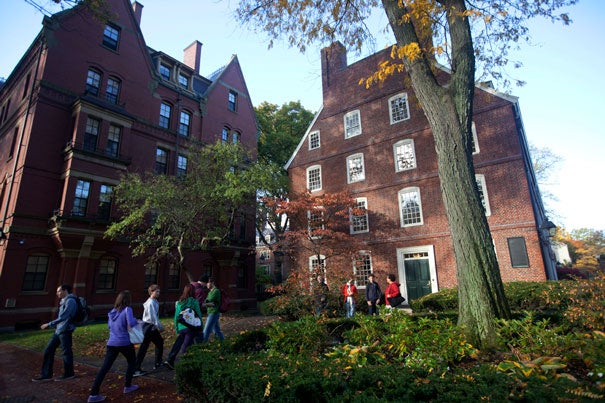
Campus Services will transition into a shared services model to streamline common functions such as administrative, financial, and business systems support.
Kris Snibbe/Harvard Staff Photographer
New Campus Services department takes shape
Sustainability efforts further integrated into operations
Campus Services, the administrative group that serves every School and unit across the University, announced plans today (Nov. 18) to increase efficiencies and strengthen the University commitment to sustainability.
Vice President for Campus Services Lisa Hogarty said that the administrative departments under her direction will transition into a shared services model to streamline common functions such as administrative, financial, and business systems support. The changes come after a five-month review of the departments and are part of Executive Vice President Katie Lapp’s efforts to improve central administrative coordination and efficiency.
“By realigning portions of Campus Services we can de-silo our departments, reduce bureaucracy, and simplify administrative processes in a way that can preserve jobs and better serve the University community,” said Hogarty. “Whenever there are reductions in our overhead costs, whether gained by sharing best practices in purchasing or creating simplified ways to access our services, our clients ultimately benefit.”
As part of the new, shared departmental structure, groups formerly under the University Operations Services (UOS) umbrella (Environmental Health and Safety, Transportation Services, etc.) will become individual groups within Campus Services.
Jim Gray, who has served as associate vice president of Harvard Real Estate Services (HRES), will become a special adviser for the department, effective Jan. 1. The commercial and residential real estate functions of HRES will report directly to Hogarty. The shared structure will enable other campus service groups to capitalize on and learn from HRES’s best practices, Hogarty said.
Gray oversaw HRES’s multiyear effort to house 50 percent of Harvard’s graduate students on-campus and implemented several important and symbolic renewable energy projects, including the installation of one of the largest solar panel arrays in New England in the Arsenal at Watertown. He also helped HRES increase operational efficiency by 80 percent — the savings of which are being reinvested into Harvard’s residential and commercial real estate portfolios.
“Jim has been instrumental in transforming HRES into a highly efficient organization and we continue to rely on his expertise as we transition into a more cohesive administrative unit that continually improves the quality of our service delivery,” Hogarty said.
Key sustainability functions will also be realigned within Campus Services in order to strengthen the University’s commitment to sustainability. In the new structure, the Office for Sustainability’s (OFS) green building services, Engineering & Utilities (E&U), and Facilities Maintenance Operations (FMO) will be rolled into a new department dedicated to energy, facilities, and sustainable building services. The occupant engagement and outreach services will remain in the OFS, and will continue to be led by Heather Henriksen. In addition, this group will become more of an incubator for innovative programs related to sustainability. Seamless integration between the building services and occupant engagement and outreach functions will continue to be a high priority.
“By further integrating sustainability across Campus Services we are significantly strengthening our ability to reduce emissions and achieve our ambitious greenhouse gas reduction goals. This is the next step in greening the Crimson,” Hogarty said.
Rolling sustainability functions into the operations of key administrative departments will also ensure that energy- and resource-saving measures are a part of everyone’s day-to-day responsibilities, Lapp said.
“The University’s sustainability agenda has gained incredible momentum and touches every member of the Harvard community today,” said Lapp, who noted that most of Harvard’s greenhouse gas emissions are generated by heating, cooling, and powering buildings, most of which are managed or supported by Campus Services staff in collaboration with the Schools and units.




